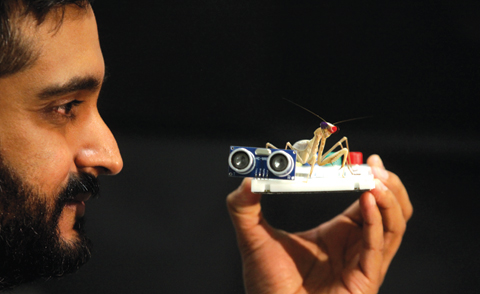'Current machine stereo algorithms require a lot of computing power'
 NEWCASTLE: This handout picture received on February 7, 2018 from Newcastle University shows Dr. Vivek Nitanyanda holding aloft a praying mantis fitted with miniature 3D glasses, in a research facility at Newcastle University. —AFP
NEWCASTLE: This handout picture received on February 7, 2018 from Newcastle University shows Dr. Vivek Nitanyanda holding aloft a praying mantis fitted with miniature 3D glasses, in a research facility at Newcastle University. —AFPPARIS: Praying mantises sporting tiny 3-D glasses that were held in place with beeswax have revealed a new kind of "stereo" vision that may help improve robot sight, researchers said Thursday. With two teardrop-shaped, light-filtering lenses perched on their heads, the insects lashed out in lab experiments at images of tempting prey in a special 3-D film, a team of scientists said. Scientists then observed the insects' reaction to more complex images, and learnt that mantis vision works very differently to ours.
"Mantises only attack moving prey, so their 3-D doesn't need to work in still images," said Vivek Nityananda of Newcastle University, one of the authors of a study published in the journal Current Biology. "We found mantises don't bother about the details of the picture, but just look for places where the picture is changing," he said in a video explaining the experiment. This was the case even when each eye looked at two completely different images-an ability humans don't share.
According to fellow researcher Jenny Read, this was a simpler method of 3-D vision, and could have implications for building lighter machines, such as drones. "Current machine stereo algorithms require a lot of computing power," she said. "Reducing the amount of computer power necessary means smaller, lightweight robots could use mantis stereo algorithms to detect depth."
'Fundamentally' different
Also known as "stereopsis", 3-D or stereo vision helps humans and other creatures determine the distances to objects we see. Each eye sees an object at a slightly different angle, but the brain merges the two images together and uses the difference to calculate how far something is. Other animals with this ability include monkeys, cats, horses, owls and toads, said the research team.
The mantis is the only insect known to have stereo vision, but given its tiny brain, scientists have long suspected it must involve a simpler process. To test this, the team created special, tiny 3-D glasses out of blue and green-colored filters, and used beeswax to fit them to 10 adult insects. The experiment revealed that mantis stereopsis "uses a fundamentally different computational algorithm", they said. "Thus, while there is no evidence that mantis stereopsis works at all with static images, it successfully reveals the distance to a moving target." -AFP









